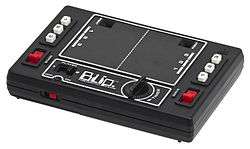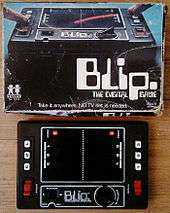Blip (game)
| Blip | |
|---|---|
 | |
| Developer(s) | Tomy |
| Publisher(s) | Tomy |
| Designer(s) | Hikoo Usami |
| Release date(s) | 1977 |
| Sound | None |
Blip was a hand-held electro-mechanical game marketed by Tomy starting in 1977. The game was a simulator of games like tennis, ping-pong, and Atari's video game Pong.
Gameplay
For a two-player game, the game's selector switch was set to position 2 (for two players). The game was then turned on and the red LED ball lit up. Whichever side the ball was on served first. The server's score counter was set to "0" while the receiver's counter was set to "R". The timer was then turned. A push of the "serve" button began the game. The players must anticipate where the ball would land in one of three spaces on the "playing field" marked 1, 2, and 3. The player must then push the corresponding button before the ball "lands" on the space. If the player was successful in anticipating the ball's space and pushed the button in time, the ball was then "returned" to the opposing player. If the player anticipated wrongly, the ball would stop and that player must then serve the ball, giving the opposing player 1 point.
Game play continued until either the timer stopped or 10 points was earned by one of the players.
Blip was also capable of being played by a single person when the selector switch was set to position 1.
Development and history

Blip was designed by Hikoo Usami for the Tomy Kogyo Co., the patent being filed in 1976 and awarded in 1977. The game was housed in a plastic case with a translucent screen. On the screen was a hash line dividing the screen in half (and simulating a net) and contained the three positions for the ball to land for both sides. The upper portion of the case also contained the 1, 2, and 3 position buttons, the serve buttons, the player selector, and the timer dial. The underside contained the wheels to turn the score counters and the battery compartment.
It was the timer which provided the motor function to the game. Upon the timer dial being turned, this wound a spring which then, via several gears, drove the arm upon which the LED light (the ball) was mounted.
Movement of the LED was ostensibly random but a player was capable of memorizing the movements of the LED and recognize patterns which would enable the player to better anticipate where the "ball" would land.
Power for the LED was provided by two AA batteries. However, because the game was mechanical, in the right light conditions, it was possible to play Blip without batteries as one could see the unlit LED under the screen.
Tomy marketed Blip in the U.S. starting in 1977 and it was a very popular game when it debuted, being one of the "must have" holiday gifts for the 1977 Christmas shopping season. In Japan, Blip was marketed as World Tennis and differed from the U.S. game by having the words "World Tennis" emblazoned on the screen and replacing the 1, 2, and 3 on the screen with silhouettes of tennis players. The Blip name remained on the Japanese version. In France, the game was marketed by Meccatronic. The German version was called Blip-o-Matic, although the Blip name remained on the case.